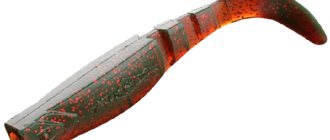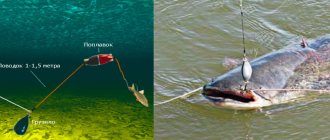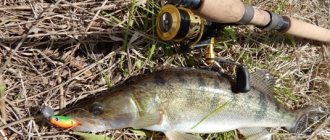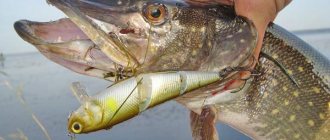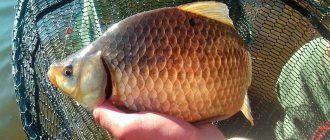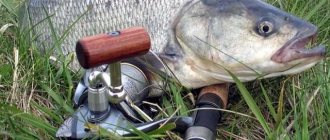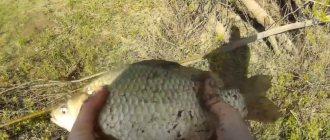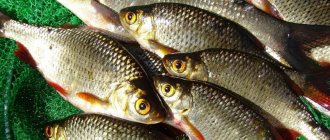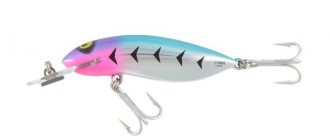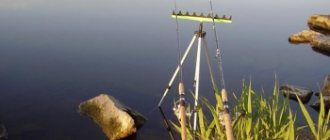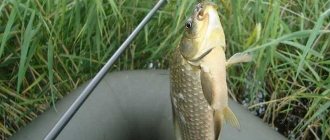Features of spinning fishing in spring
In the spring, in the regions of Russia, bans on fishing with spinning rods, which usually work in natural reservoirs during spawning, begin to apply. Therefore, before going fishing, you need to check when and where it is prohibited. Otherwise, you may run into trouble in the form of heavy fines and confiscation of your catch. If you plan to fish on paid reservoirs, the problem does not arise. As a rule, there are never any restrictions on them.
You should be well prepared for fishing in the spring. At this time of year, the weather is unpredictable, and warmth can quickly give way to cold wind and rain. It is necessary to choose equipment so as not to suddenly freeze or get wet. It is advisable to wear a waterproof suit and warmly lined waders. It won’t hurt to wear thermal underwear, a sweatshirt, a hat made of waterproof material and take the same mittens with you.
Types of fish for spinning fishing in spring
In the spring you can catch:
1. Pike. After the ice melts, the predator goes to shallow water, where the water warms up faster, and before and after spawning, the fish begins to eat heavily. She greedily grabs any bait.
2. Pike perch. In spring it is not very active, but can bite well in winter mooring areas and in places with uneven bottom topography.
3. Perch. This predator falls for small baits. Small and medium-sized specimens gather near the shore in the spring to feed on the eggs of other fish, and can enter spills. Large perches appear in the coastal zone in late April - early May. Before this, they need to be caught with long-distance casts.
4. Chub. It becomes active two weeks after the ice melts and moves to spawning grounds. Fish can be found in tributaries, near river mouths. In April, small chub concentrate near the shore, near bushes and hanging tree branches. Large individuals stay 20-30 meters from the coastline.
5. Asp. Before spawning it must be looked for at great depths, after - in shallow water. Asp rarely approaches the shore and actively bites at a decent distance from it in the second half of spring. The zhor stops during the spawning period, which lasts only a short time at different times from the last days of April until the water in the reservoirs subsides. It is caught using jig baits and wobblers.
When can you start spinning fishing in the spring?
The success of spinning fishing in the spring depends on the characteristics of the reservoir and the behavior of a particular fish, which differs among different breeds. When can you start fishing based on these conditions?
1. Pike. The predator can be caught after the first gullies appear in bodies of calm water. In rivers, ice breaks first in areas with strong currents. There are no pike on them. Toothy is waiting for places with holes and reverse flow to open up.
2. Pike perch. It is actively caught using a spinning rod only after the ice has completely disappeared from the reservoir. The pike perch begins to bite well earlier, but floating ice floes make it difficult to cast the bait far, to carry out the retrieve correctly, and to get to the fish’s mooring areas by boat.
3. Perch. He begins to greedily hunt for bait immediately after the appearance of gullies created by melt water. Closer to spawning, the predator bites poorly.
4. Chub, asp. This fish is difficult to catch until the water warms up to a temperature of +9ºС. At the beginning of spring, it stays at great depths and rarely pays attention to bait. Then, as the water warms up, it moves to shallow water or to the shore.
Fishing for pike perch
Over time, as the temperature warms, coastal areas of ice-free water increase in size, opening up more and more promising places for fishing. Places remote from the shore with good depths become accessible for casting. In such places, in addition to perch and pike, you can also count on pike perch. In early spring, pike perch practically do not approach shallow depths; they prefer deeper places with an “interesting” bottom topography. Most often these are edges remote from the shore and snags with decent depths. I noticed that in early spring, until the last ice melts, the entire zander population can be roughly divided into two groups. One part of the pike perch remains in their wintering pits, which are usually far from the shore. The other part of the pike perch gathers in schools and begins to “patrol” the reservoir in an active search for food. Most often, you can run into such a “patrol” on a noticeable dump not far from the shore with depths of 3 m. What else I noticed about the depth: - in early spring, predatory fish prefer to hunt at greater depths than in the summer, but not as deep as late autumn or winter. I observed this behavior of pike perch in reservoirs with stagnant water or low current. I have no serious observations of pike perch in rivers with strong currents. In addition to deep-water edges far from the shore, pike perch also likes to visit quiet bays in early spring. Especially if the weather is clear and sunny, without wind. In such weather, large schools of white fish - roach and even bream - emerge from under the ice to bask in the bright spring sun. Pike perch are attracted like a magnet to such schools of white fish. He is always nearby, only lower, in the depths. Like a shepherd, he tends such flocks, hiding at the very bottom in a snag or behind the edge.
Features of reservoirs
Fishing in different bodies of water begins at different times, which is regulated by the speed of the current, the level of water rise, and the types of flood.
1. Small rivers. The water level in them rises by 30-50 centimeters and quickly decreases. You can start catching pike a week after the ice melts.
2. Big rivers. In them, water rises to a height of up to two meters during ice melting and can flood the coastal coastal zone. In this case, you need to hunt for pike before the flood, as it will make the water cloudy.
3. Lakes. The water level in them in spring depends on the number of tributaries and the volume of snow that lies on the shore. The water in lakes does not rise as much as in rivers and quickly becomes clear. Fishing with a spinning rod can be successful immediately after its level decreases.
Artem (Testmaker)
Tell us, what type of reservoirs do you pin your hopes on in the spring - the Ob, small and micro rivers, or your main hopes for the opening of the water reservoirs and lakes?
My main body of water for both training and relaxation is the Mother Ob. I mainly go fishing on the Ob River. Every year she throws up different problems that are very interesting to solve: it seems that you know your entire home shore, but it turns out completely wrong. Here is one example: quite recently there was a year of Huge Water - you begin to adapt, come up with something new, find points which in low water I simply passed by and did not even consider as promising. It seems to me that the spring Ob is the most interesting for us in terms of constantly changing fishing conditions, which requires constant flexibility, flight of thought, imagination - which is what I like most.
We know that you prefer fishing from the shore. What criteria for a fishing location are paramount for you?
If we are considering the spring period, then most likely I will start with those places that are familiar to me, both in terms of relief and time of departure. A familiar shore allows you not to spend a lot of time searching for points - I know the points and thus have more time for the fishing itself. But even at familiar points you may not get a single bite, since fish are very capricious in the spring. On an unfamiliar body of water, I start my search from the relief - that is, I tap with a jig. While I’m looking for relief, I look at various current anomalies on the surface of the water, which can tell me where to look for fish.
How do you assess the prospects for catching a spring predator? Which one will be more and which one less active, in your opinion?
The main spring predator is, of course, perch. Minke whales are simply present in the river in greater numbers than any other predator. I will be focusing on catching perch using ultra-light tackle. The sensations from such fishing are in no way inferior to catching trophy pike or pike perch, only the fish are smaller and the tackle is lighter. I usually release the bulk of the perch catch. The rest of the predatory inhabitants will begin to become more active depending on weather conditions; it’s difficult to predict here, but I deliberately try not to catch pike perch and pike in the spring, due to spawning.
Fishing from a boat and from the shore using a spinning rod in spring
In early spring, in large bodies of water, fishing from the shore is the most promising. It is more convenient and safer to approach fish habitats from there. This:
1. Hollows on rivers.
2. Non-freezing areas.
3. Ice-free areas in ponds with standing water.
For fishing from the shore, fast action forms with a length of 2.2 meters to 2.8 meters are suitable. Fishing from a boat becomes available after the ice has completely disappeared. Light and ultra-light spinning rods with a length from 1.8 meters to 2.4 meters with a fast, medium, parabolic action are suitable for it.
Safety precautions
When fishing on the last ice in March, you need to remember safety . When moving on the ice, you need to be extremely careful, as in March it is weak and brittle. It is recommended to go out on spring ice only in a life jacket.
When fishing from a rubber boat, you must remember that ice plates floating in meltwater can cut through the inflatable boat.
You cannot keep the boat sideways to strong winds and waves. In case of unfavorable weather forecast, you should refrain from fishing on the water from a boat.
How to choose equipment for spinning fishing in spring
Equipment for spinning fishing in the spring is selected taking into account the type of fish that you plan to catch.
1. For pike hunting. To catch predators, you will need a medium action spinning rod with a weight of 2 grams to 30 grams. The rod is equipped with a powerful reel ranging in size from 2500 to 3000 with a front friction brake, a durable braided cord, and a metal leash.
2. For fishing for pike perch. Hunting for this fish is usually carried out using a jig. You need a quick formation form with a test depending on the depth and current speed. A reliable spinning or multiplier reel is mounted on it, a braided cord and a fluocarbon leash are tied if fishing is carried out on snags and rock-filled reservoirs.
3. For perch fishing. Light fast-action blanks with dough from 2 grams to 14 grams, reels with sizes from 500 to 1000, monofilament or braided cord with a diameter of 0.08 millimeters to 0.16 millimeters are suitable for it.
4. For catching asp and chub. In this case, the most convenient will be universal spinning rods of ultra-fast and fast action with tests reaching 15 grams in early spring, and 30 grams in the period after spawning. Reels of size 2500-3000 are placed on them and monofilament is attached. Braided line is not used when catching this fish.
How to properly equip a spinning rod
The equipment of a spinning rod when fishing in March depends on the type of fish that you plan to fish. When equipping a spinning rod, you also need to take into account the characteristics of fishing in early spring.
- It is recommended to catch pike using a spinning rod with a hard rod, the length of which does not exceed four meters, with a soft tip. For equipment you need a fishing line with a diameter of 0.5 - 0.4 mm.
- When fishing for pike perch, the length of the spinning rod should not exceed three meters; braid is used instead of fishing line.
- to equip a spinning rod for carp fishing in March with a fiberglass rod, since carp is a strong fish, and the tackle must be strong enough. The fishing line used for rigging is as inconspicuous as possible, but strong enough to support large fish. The thickness of the fishing line is also selected taking into account the possibility of snagging when fishing.
Regardless of the type of fish you plan to catch, the hooks must be strong and massive.
Lures for spinning fishing in spring
Lures for spinning fishing in the spring should be selected based on the fishing method and type of fish.
1. Jig. It is used when hunting a predator lurking at the bottom. The most popular jig baits are twisters, vibrotails, and silicone worms. There are reservoirs in which spawning lamprey appears in the spring. Its imitations are of great interest to pike and zander. When fishing before spawning, baits should be large, and after spawning – small.
2. Wobblers. They are suitable for fishing for pike in shallow water, in areas overgrown with underwater plants. In March-April, the predator attacks large, actively playing minnows, jerkbaits, and crankbaits; in May, after spawning, it bites on slow-playing minnows. Wobblers are an excellent option for catching chub and asp near the shore. They can simply be set adrift in areas that are attractive for fish.
3. Spoons. They will be the best choice for catching predators in shallow water and in thickets. Heavy spinners provide precision long casts. It is important that their petals can play well. Small spoons can be used when hunting pike, pike perch, asp at depth or on rivers with strong currents. In early spring, you need to choose bright, aggressively colored spoons; closer to summer, silver or greenish baits.
Lures are selected taking into account the preferences of the fish before and after spawning. At the beginning of spring, pike bite well on spinners, perch on vibrotails and twisters, pike perch is interested in foam rubber, chub and asp prefer wobblers.
Wiring for spinning fishing in early spring
There are different methods of conducting, but all of them are united by the pace: it should be slow, calm, bordering on a complete stop.
Lures and fishing methods
Any experienced fisherman will confirm that for each bait there is a certain way of “presenting”, its own style. To be successful in fishing, a spinning angler must choose a method of retrieving each bait that will help it most naturally imitate any living food object. And, believe me, there are often cases when an ordinary “foam rubber”, but in experienced hands, brings a good catch of pike-perch, but a “cool” wobbler, with inept wiring, does not give a single bite. It is clear that there are completely “no bite” days, when for some reason the fish are completely passive, in some kind of half-asleep state. But still, much more often, an angler fails precisely because of an inaccurate choice of bait or an inappropriate style of fishing. It is very important to remember your observations of various baits while fishing. It is important to remember at what depths this or that bait is most effective. It is worth noting which predator is most attracted to a particular bait, and for what size of fish it is most suitable. Well, and, of course, the conditions of the fishing location play a huge role in the choice of bait. And, based on local conditions, it is worth selecting a suitable wiring diagram for each bait. I will share with you my scheme for choosing bait when fishing. After a brief study of the fishing location (depth, current speed, bottom topography, etc.), based on my experience, I choose the bait that seems most suitable to the given conditions. If after several casts I do not get a positive result, then I begin to change the wiring style. If changing the wiring methods did not help, then I choose another bait and start experimenting with it.
In fact, in early spring, both pike and pike perch are quite active and are not so capricious in their choice of bait.
For example, pike perch is very partial to any jig bait, and especially if it is presented correctly - correctly loaded and moves attractively with a stepped retrieve. Pike, if standing at a decent depth, can also be caught well with a jig. In addition, pike this season can be easily seduced by both wobblers and spinners - both spoons and spinners. But I try not to use wobblers during this period. The fact is that the best results are obtained when casting the bait to the very edge of the ice. Quite often, with such “jewelry” casts, snags on an ice floe occur. The ice at the beginning of spring is no longer smooth, but rough and porous - the hook in such ice clings tightly - you can say goodbye to the wobbler. Well, a good wobbler is not a cheap thing. So, purely for “selfish” reasons, I try to use simpler baits and often from the “unhooked” series, although this does not always save me from losses. Usually in deep places, both for pike perch and for pike, the most popular ones for me are “foam rubber” (non-snagging). The predator is quite good at catching both vibrating tails and twisters. Moreover, I mount baits both on a jig head and on an offset hook. Pike hunt more often in shallow places. For catching pike in shallow places, the same “rubber”, the same twisters and vibrating tails are suitable, but they need to be mounted on light-weight heads. Light spinners, also from the “non-snagging” series, also work great in shallow water. I select oscillating spoons for this kind of fishing according to the principle - the cheaper, the better. Usually, inexpensive spinners are not much inferior to expensive fancy “brands”, except perhaps in the quality of the hooks. But losing them is not so expensive. Now about the wiring. If you decide to catch pike with a spoon in a shallow place, then the fishing here needs to be calm and unhurried. Lightweight spinners made of thinner metal cope well with this role. Even with a leisurely retrieve, such spoons float beautifully in the water. Jig baits are still better suited for catching pike perch, and it is better to use them in a “step” manner. If you catch pike with jig baits, then you simply cannot do without experimenting with the speed and method of retrieving. For each place and for each specific case, both stepped and more uniform wiring can be more successful. Sometimes I use something between stepped and uniform wiring - I get some kind of smooth, wave-like movement of the bait. What I would like to draw your attention to is that when choosing a wiring method, it is important to be able to select the right bait. Almost all types of baits are suitable for stepwise uneven retrieving, but, in my opinion, an ordinary foam fish is the best. For uniform retrieving, the most suitable baits are those that have their own game. There are models of vibrating tails and twisters that, due to the structural features of their “body,” play attractively even without the help of a spinning rod, with even wiring. Finally, a little about choosing gear. Let me remind you that we are talking about fishing in early spring. The ice has not yet completely melted, but has only moved a little away from the shore. Although long casts are not expected during this period, I still use a long spinning rod, about 3 or 3.6 meters. This length of the spinning rod makes retrieving more comfortable. The casting accuracy with such a rod drops a little, but due to the fact that you don’t have to cast far, this somehow smooths out the situation. The main task is to send the bait as close to the edge of the ice as possible and move it along the edge. For clarity, I sketched out a simple fishing diagram - I noted promising angler spots and a casting pattern. So, let me remind you, we choose a spinning rod with a length of 3 to 3.6 meters, light and sensitive. The action of the rod is medium to fast. Choosing a reel model is up to your taste. The fishing line I prefer is braided. That's probably all. Source
Spinning fishing techniques and tactics in spring
Spinning fishing techniques in the spring differ from fishing at other times of the year only in the peculiarities of the fishing. During the period after the ice melts, they should be smooth and slow. A fast moving bait can scare away sleepy and lethargic fish. As summer approaches, the speed of posting increases. They can be:
1. Uniform. The line is wound onto the spool evenly, without changing the number of movements. They work only with a reel, keeping the spinning rod in one position. The speed of the retrieve depends on the depth of the bait. This method is used when fishing in the middle layers of water and near the surface.
2. Uneven. In this case, the line is wound at a variable speed. The bait should float, sink, and move chaotically. To make her play more active, twitch the tip of the form up, down and to the sides.
3. Stepped. After casting, wait for the bait to fall to the bottom. The fishing line is reeled in so that the bait rises 40-50 centimeters, stands, then drops 40-40 centimeters, then rises again, and so on. The spinning rod is moved down, up, and to the sides. This type of fishing with floating wobblers is the most effective when catching a sleepy, lethargic predator.
4. Ryvkov. Such wiring is suitable for twitching with poppers and minou. Spinning is used so that the bait actively moves from side to side. They regularly pause and jerk while reeling in the fishing line. When hunting for perch, you need a small amplitude of oscillations of the bait; for pike and pike perch, wide and sweeping oscillations are needed. The softness of the retrieve and the length of pauses between jerks depend on the behavior of the fish. The more active the predator, the harsher the wiring and the shorter the duration of pauses. To implement the jerk method, you need a short spinning rod with a braided cord. Monoline does not allow you to animate the bait well.
5. Pendulum. Such wiring is suitable for snags, ponds overgrown with underwater vegetation, littered with trees, and for rivers with fast currents. After the bait falls to the bottom, the spinning rod is placed in a horizontal position and pulled up 10-15 centimeters. The bait should rise. The idea is to move the rod 5-10 centimeters forward so that the bait falls to the bottom again.
Anton (Fisher-Man)
In the spring, as you know, there is a spring ban. Will you use the time before the ban to go fishing from a boat?
For me, spring spinning means fishing primarily from a boat on the Ob, first within the city, then, when the ice washes away, downstream in the Kolyvan area. During the winter, I miss the rumbling of the engine, the wind and splashes in my face, and the angry bites in my hand, so much that I go out on the water as soon as the ice washes away. Usually mid to late March, depending on the weather. If it weren’t for my slightly frostbitten, freezing hands, I would have been out on a boat in January))) Although pundits, as well as some experienced fishermen, say that it is best to look for fish in sun-warmed shallow waters in early spring, I, out of old habit, I'm looking for a predator in the pits or near them. At least in the pits the pike, even if inactive, always stands in early spring. And if there is definitely a fish, then there is a chance to catch it.
What fishing methods do you prefer at this time of year?
Jig. This is my main and favorite method of fishing. But early spring jig is somewhat different from summer and autumn. Due to the fact that the fish is very passive, it is necessary to do the retrieve as slowly as possible. Minimum possible load, small, up to 8 cm, rubber. And the duration of the pause is no less than 3-5 seconds. This was the only way I could get the sluggish fish to bite. And one more big difference: from a tool for searching for active fish, jig turns into fishing for passive ones. It is useless to rush along the river and look at all potentially promising places. I stand in holes known to me, where the predator is 100% present, and carefully fish for a long time. Sometimes bites follow almost immediately, and sometimes there is only one small outbreak per day.
Do you have to fish from the shore in the spring?
I rarely fish from the shore in the spring, as the fish still stick to the riverbed. And in general, since I got a boat, I’ve become very lazy - I’m used to comfort)) But if I’m discouraged, after studying I’ll go to Matveevka.
